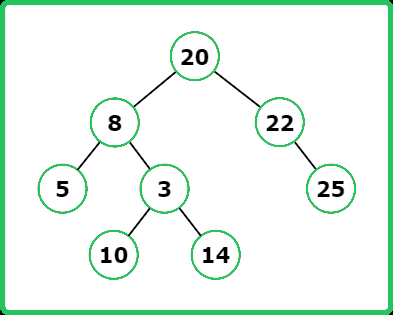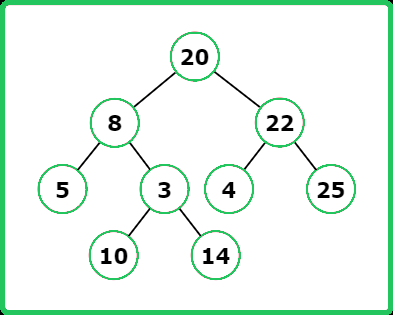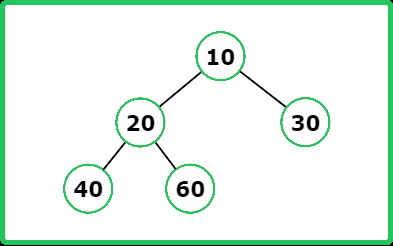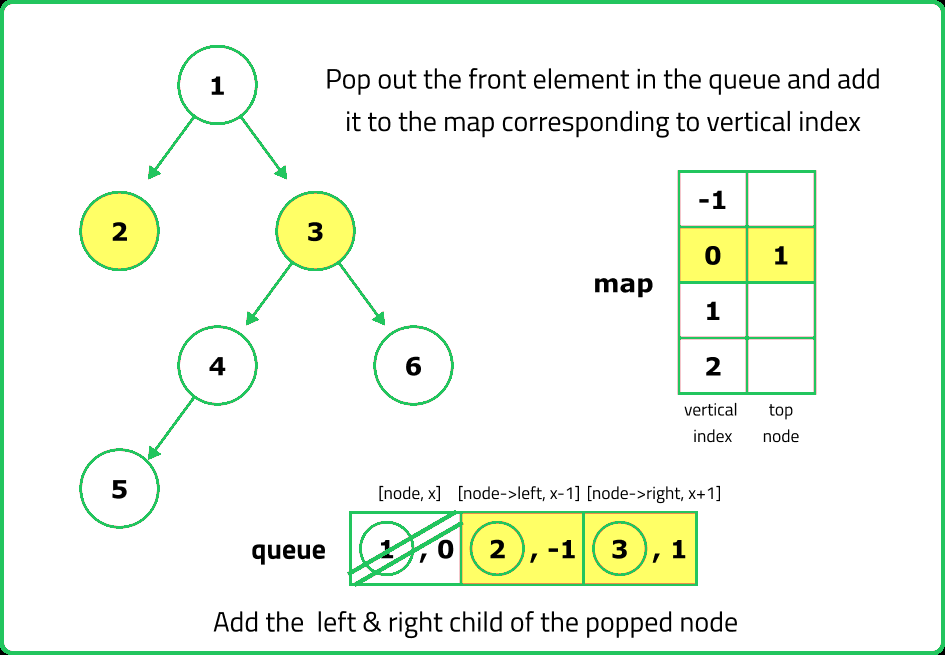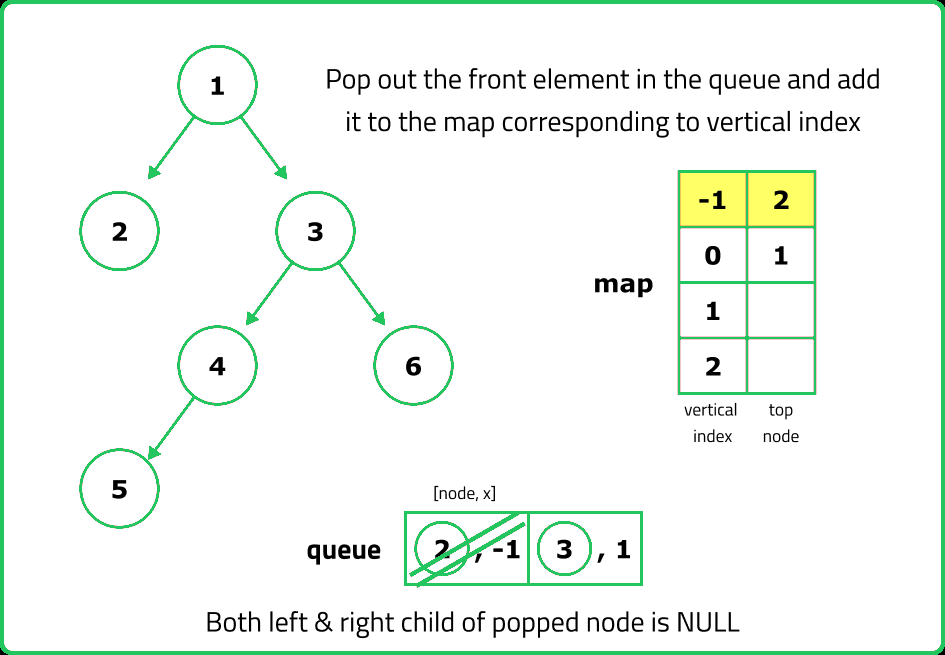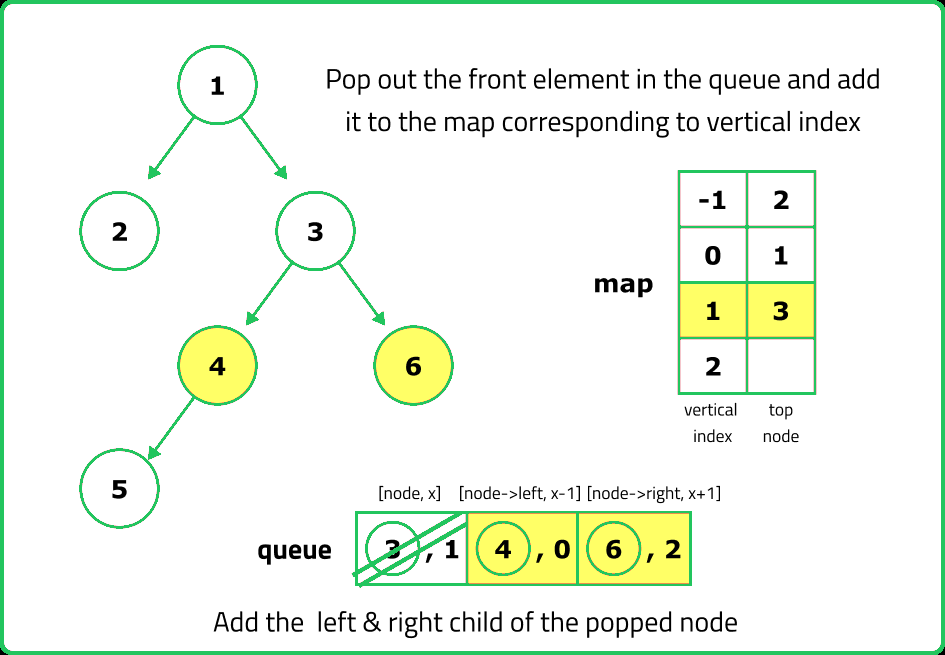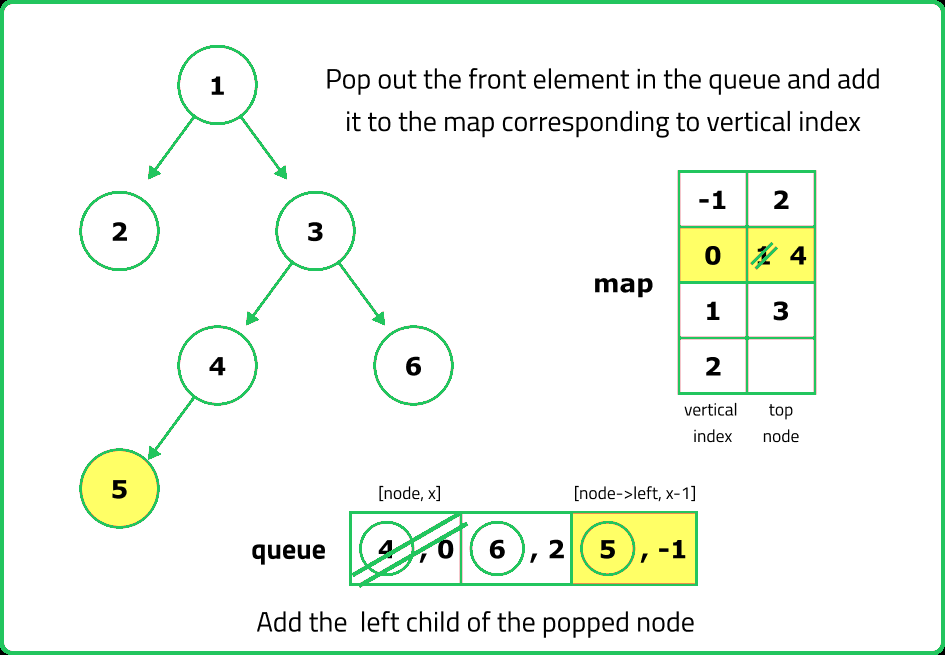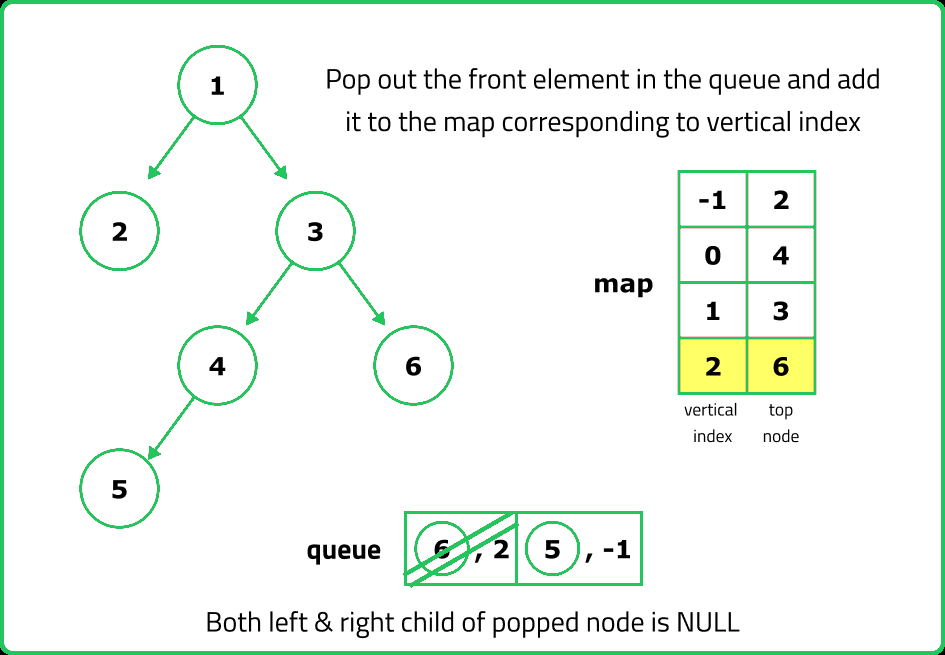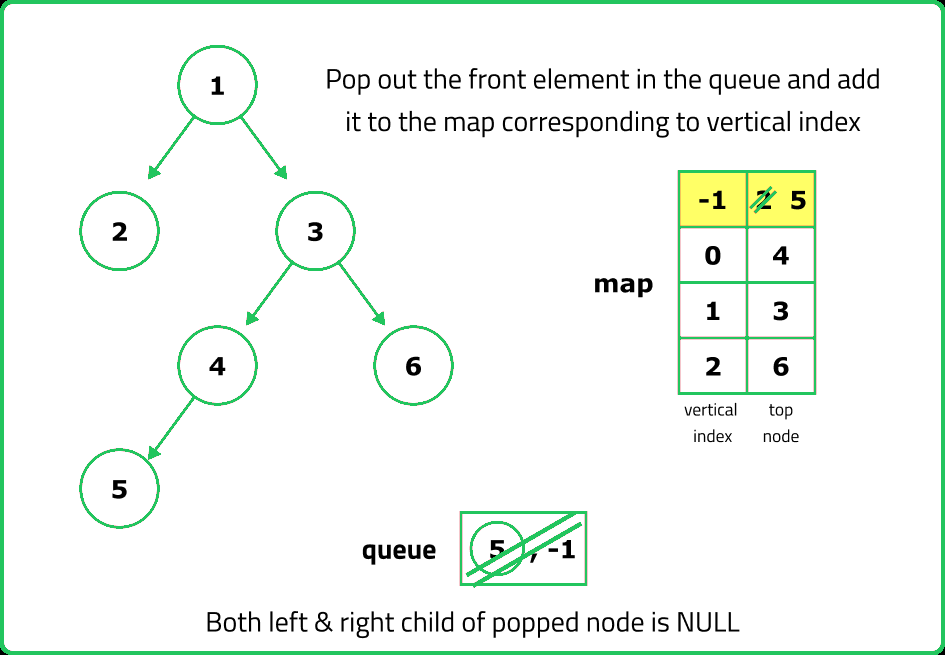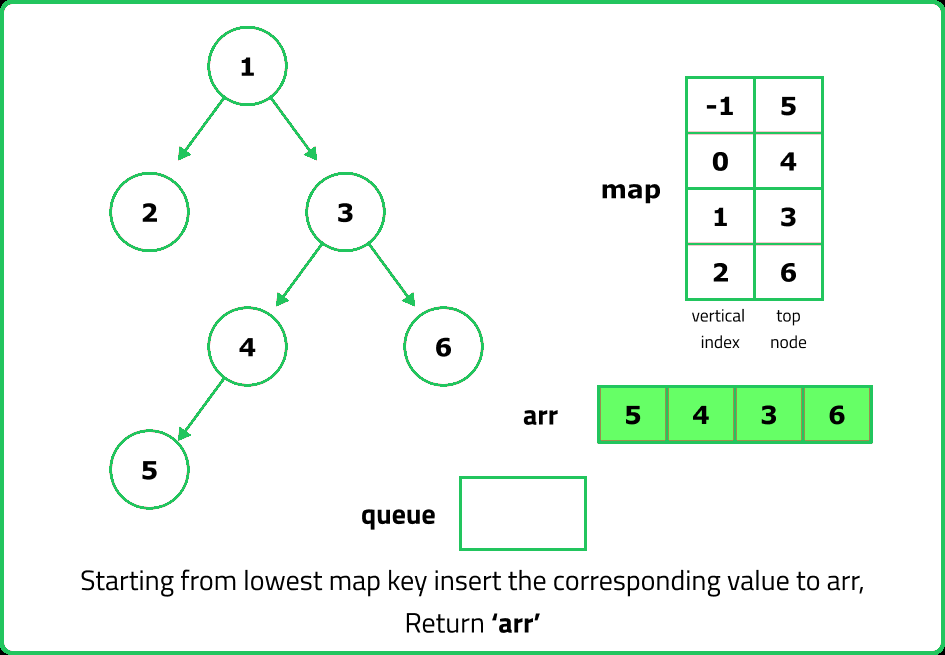123456789101112131415161718192021222324252627282930313233343536373839404142434445464748495051525354555657585960616263646566676869707172737475767778798081828384858687888990919293949596979899100101102103
#include <bits/stdc++.h>
using namespace std;
// Definition for a binary tree node.
struct TreeNode {
int data;
TreeNode *left;
TreeNode *right;
TreeNode(int val) : data(val), left(nullptr), right(nullptr) {}
};
class Solution {
public:
vector<int> bottomView(TreeNode *root) {
// Vector to store the result
vector<int> ans;
// Check if the tree is empty
if (root == nullptr) {
return ans;
}
// Map to store the bottom view nodes
// based on their vertical positions
map<int, int> mpp;
// Queue for BFS traversal, each
// element is a pair containing node
// and its vertical position
queue<pair<TreeNode*, int>> q;
// Push the root node with its vertical
// position (0) into the queue
q.push({root, 0});
// BFS traversal
while (!q.empty()) {
// Retrieve the node and its vertical
// position from the front of the queue
auto it = q.front();
q.pop();
TreeNode* node = it.first;
int line = it.second;
// Update the map with the node's data
// for the current vertical position
mpp[line] = node->data;
// Process left child
if (node->left != nullptr) {
// Push the left child with a decreased
// vertical position into the queue
q.push({node->left, line - 1});
}
// Process right child
if (node->right != nullptr) {
// Push the right child with an increased
// vertical position into the queue
q.push({node->right, line + 1});
}
}
// Transfer values from the
// map to the result vector
for (auto it : mpp) {
ans.push_back(it.second);
}
return ans;
}
};
int main() {
// Creating a sample binary tree
TreeNode* root = new TreeNode(1);
root->left = new TreeNode(2);
root->left->left = new TreeNode(4);
root->left->right = new TreeNode(10);
root->left->left->right = new TreeNode(5);
root->left->left->right->right = new TreeNode(6);
root->right = new TreeNode(3);
root->right->right = new TreeNode(10);
root->right->left = new TreeNode(9);
Solution solution;
// Get the Bottom View traversal
vector<int> bottomView = solution.bottomView(root);
// Print the result
cout << "Bottom View Traversal: " << endl;
for (auto node : bottomView) {
cout << node << " ";
}
return 0;
}
1234567891011121314151617181920212223242526272829303132333435363738394041424344454647484950515253545556575859606162636465666768697071727374757677787980818283848586878889909192939495969798
import java.util.*;
class TreeNode {
int data;
TreeNode left;
TreeNode right;
TreeNode(int val) {
data = val;
left = null;
right = null;
}
}
class Solution {
public List<Integer> bottomView(TreeNode root) {
// List to store the result
List<Integer> ans = new ArrayList<>();
// Check if the tree is empty
if (root == null) {
return ans;
}
// Map to store the bottom view nodes
// based on their vertical positions
Map<Integer, Integer> mpp = new TreeMap<>();
// Queue for BFS traversal, each
// element is a pair containing node
// and its vertical position
Queue<Map.Entry<TreeNode, Integer>> q = new LinkedList<>();
// Push the root node with its vertical
// position (0) into the queue
q.add(new AbstractMap.SimpleEntry<>(root, 0));
// BFS traversal
while (!q.isEmpty()) {
// Retrieve the node and its vertical
// position from the front of the queue
Map.Entry<TreeNode, Integer> it = q.poll();
TreeNode node = it.getKey();
int line = it.getValue();
// Update the map with the node's data
// for the current vertical position
mpp.put(line, node.data);
// Process left child
if (node.left != null) {
// Push the left child with a decreased
// vertical position into the queue
q.add(new AbstractMap.SimpleEntry<>(node.left, line - 1));
}
// Process right child
if (node.right != null) {
// Push the right child with an increased
// vertical position into the queue
q.add(new AbstractMap.SimpleEntry<>(node.right, line + 1));
}
}
// Transfer values from the
// map to the result list
for (Map.Entry<Integer, Integer> it : mpp.entrySet()) {
ans.add(it.getValue());
}
return ans;
}
public static void main(String[] args) {
// Creating a sample binary tree
TreeNode root = new TreeNode(1);
root.left = new TreeNode(2);
root.left.left = new TreeNode(4);
root.left.right = new TreeNode(10);
root.left.left.right = new TreeNode(5);
root.left.left.right.right = new TreeNode(6);
root.right = new TreeNode(3);
root.right.right = new TreeNode(10);
root.right.left = new TreeNode(9);
Solution solution = new Solution();
// Get the Bottom View traversal
List<Integer> bottomView = solution.bottomView(root);
// Print the result
System.out.println("Bottom View Traversal: ");
for (int node : bottomView) {
System.out.print(node + " ");
}
}
}
123456789101112131415161718192021222324252627282930313233343536373839404142434445464748495051525354555657585960616263646566676869707172737475767778
from collections import deque
# Definition for a binary tree node.
class TreeNode:
def __init__(self, val=0, left=None, right=None):
self.data = val
self.left = left
self.right = right
class Solution:
def bottomView(self, root):
# List to store the result
ans = []
# Check if the tree is empty
if not root:
return ans
# Dictionary to store the bottom view nodes
# based on their vertical positions
mpp = {}
# Queue for BFS traversal, each
# element is a pair containing node
# and its vertical position
q = deque([(root, 0)])
# BFS traversal
while q:
# Retrieve the node and its vertical
# position from the front of the queue
node, line = q.popleft()
# Update the dictionary with the node's data
# for the current vertical position
mpp[line] = node.data
# Process left child
if node.left:
# Push the left child with a decreased
# vertical position into the queue
q.append((node.left, line - 1))
# Process right child
if node.right:
# Push the right child with an increased
# vertical position into the queue
q.append((node.right, line + 1))
# Transfer values from the
# dictionary to the result list
for key in sorted(mpp.keys()):
ans.append(mpp[key])
return ans
if __name__ == "__main__":
# Creating a sample binary tree
root = TreeNode(1)
root.left = TreeNode(2)
root.left.left = TreeNode(4)
root.left.right = TreeNode(10)
root.left.left.right = TreeNode(5)
root.left.left.right.right = TreeNode(6)
root.right = TreeNode(3)
root.right.right = TreeNode(10)
root.right.left = TreeNode(9)
solution = Solution()
# Get the Bottom View traversal
bottom_view = solution.bottomView(root)
# Print the result
print("Bottom View Traversal: ")
for node in bottom_view:
print(node, end=" ")
123456789101112131415161718192021222324252627282930313233343536373839404142434445464748495051525354555657585960616263646566676869707172737475767778798081828384858687888990919293949596979899
class TreeNode {
constructor(val = 0, left = null, right = null){
this.data = val;
this.left = left;
this.right = right;
}
}
class Solution {
bottomView(root) {
let ans = [];
if (root === null) {
return ans;
}
let mpp = new Map();
let q = [];
q.push([root, 0]);
while (q.length > 0) {
let [node, line] = q.shift();
mpp.set(line, node.data);
if (node.left !== null) {
q.push([node.left, line - 1]);
}
if (node.right !== null) {
q.push([node.right, line + 1]);
}
}
let keys = Array.from(mpp.keys()).sort((a, b) => a - b);
for (let key of keys) {
ans.push(mpp.get(key));
}
return ans;
}
}
function createTreeNode(val) {
return new TreeNode(val);
}
function main() {
let root = createTreeNode(1);
root.left = createTreeNode(2);
root.left.left = createTreeNode(4);
root.left.right = createTreeNode(10);
root.left.left.right = createTreeNode(5);
root.left.left.right.right = createTreeNode(6);
root.right = createTreeNode(3);
root.right.right = createTreeNode(10);
root.right.left = createTreeNode(9);
let solution = new Solution();
let bottomView = solution.bottomView(root);
console.log("Bottom View Traversal: ");
for (let node of bottomView) {
console.log(node + " ");
}
}
main();
